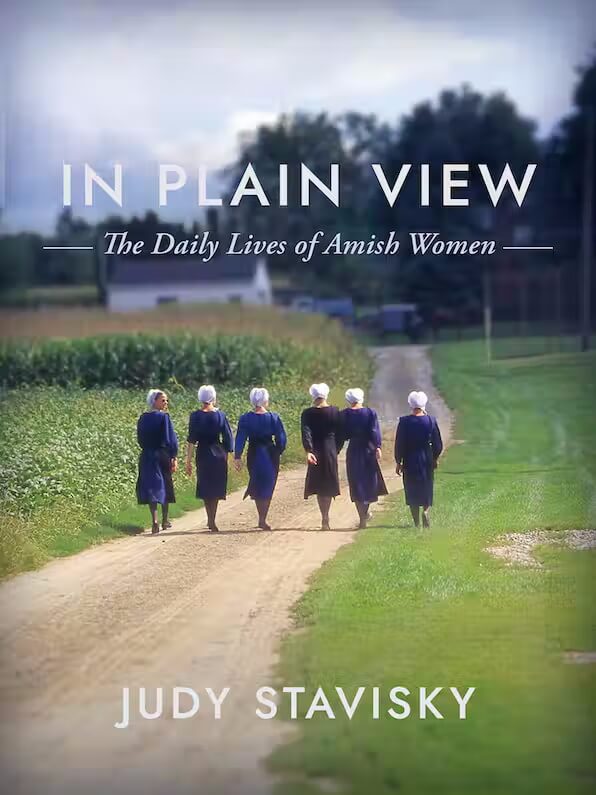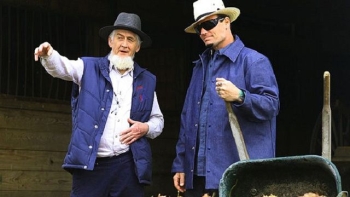Judy Stavisky on In Plain View: The Daily Lives of Amish Women (Book Giveaway)
For years now, Judy Stavisky has been driving and accompanying Amish women on shopping trips, building friendships with them and learning firsthand about their lives. Judy has compiled her experiences and insights in a new book called In Plain View: The Daily Lives of Amish Women. Here’s the description via Herald Press:
What does the life of an Amish woman really look like? Over the course of a decade, author Judy Stavisky, a curious outsider, spent hundreds of hours getting to know the women of Pennsylvania’s Lancaster County Amish community to find out the answer to this question. She joined mothers and grandmothers, unmarried women and teens, on their shopping excursions for household items, fabric, and groceries. They drove miles between undulating fields and shared hundreds of hours of conversation on everyday topics—laughing together about sneaking healthier entrees into their family’s evening meals, sharing concerns about their children, and trading family remedies for persistent coughs. As relationships evolved into enduring friendships, she grew to understand firsthand how Amish women bind their families and communities together.
In Plain View draws the reader inside a community governed by faith and separated by time, taking a closer look at the roles Amish women assume within their families and community, their fierce work ethic, and their camaraderie. Hundreds of years of shared traditions comes to life through a personal connection with Amish women, their own soft voices gently opening their world to an outsider.
Today Judy answers some questions for us on her experience with Amish women and on the book. I had a chance to read an advance copy several months ago and really enjoyed it.

Enter to win a copy of In Plain View
Along with today’s Q&A you can enter for a chance to win a copy of In Plain View. Simply leave a comment or question on this post. I’ll announce the winner here next week.
Judy Stavisky, MPH, M. Ed., has spent considerable time over the past decade attending Amish schools, sharing meals with Amish families, and joining events hosted in the Amish community. Judy has a lengthy career in philanthropy and helping non-profit organizations become more successful. She is a co-author of Do It Better! How the Kids of St. Francis de Sales Exceeded Everyone’s Expectations chronicling the journeys of Philadelphia’s student refugees. Recently Judy has been supporting Philadelphia’s refugee resettlement efforts, connecting food insecure Philadelphians with meals, and has served as part of the faculty at Arcadia and Drexel University.
Judy Stavisky on In Plain View: The Daily Lives of Amish Women
Amish America: How did you come to know the Amish, and where did the idea for this book come from?
Judy Stavisky: I moved to Philadelphia from Allentown about 40 years ago. During my grocery shopping trips to Reading Terminal Market (the city’s historic indoor Farmers Market), I observed Amish provisioners from afar. I was fascinated by Amish dress, the immaculate hair styles, and their diligence.
Frequently on weekends, my husband and I loaded our bicycles onto our car and headed to Lancaster County, a little over an hour from our home. While on our bikes, we spent hours meandering through Amish settlements, often stopping for fresh-dug potatoes and spring onions or chewy scratch-baked cookies sold at roadside stands. Silently riding by unadorned white farmhouses, the wind blowing through laundry lines of earth-colored aprons left me even more curious.

I purchased a book about the Amish each time we visited Lancaster County. Over the years, I collected scores of books. Many of them were written by Donald Kraybill, an international expert on the Amish who was then a professor at Elizabethtown College, now Emeritus.
Learning that Elizabethtown College was two hours by train from my home and only 1.5 miles from the E-town Amtrak station, I reached out to Dr. Kraybill and asked him if I might take one of his evening Amish classes. He agreed. An idyllic train ride from Philadelphia to Elizabethtown and a fascinating weekly course made my weekly commute a pure joy!
Where did you do your research and what did that look like?
Dr. Kraybill introduced me to several Amish families in an effort to assist him in updating his seminal book on the Amish, The Riddle of Amish Culture. Dr. Kraybill offered Amish women a free driver (me) to run errands with them in exchange for informal talk time with Amish shoppers.

I drove about two dozen Amish mothers and grandmothers, sisters and aunts to a myriad of grocers, dry goods and hardware stores, appliance and repair shops and health providers. While Dr. Kraybill’s competing obligations ultimately did not allow him time to update his book, he continued encouraging me – write up your visits and keep refining your notes. After over 100 visits, I had collected quite a bit of information!
What do outsiders get wrong about Amish women?
The relationship between men and women.
“There are lots of things written about us that are not true,” an Amish mother said wistfully.
Because the Amish dress similarly, those of us that live outside of their community assume that they are the same. That idea could not be further from the truth. Like the English, there are shy Amish women and those who are comfortable in most settings. I met Amish women with a bright sense of humor and those who are more staid and reserved. A number of the women I met remarked, “we are just people like you,” aware that some English tend to paint the Amish with one brush.

I also noticed how the Amish men I met, respect and appreciate their wives’ abilities at maintaining bountiful gardens, preserving mountains of produce on blisteringly hot days, and handily tailoring pants, dresses, shirts, and night clothes for every family member. Preparing meals for families of nine or 10 along with 100-plus person church and youth gatherings requires stamina and finely honed organizational skills.
Amish life excludes modern conveniences like microwave ovens or electric toasters, dishwashers, and clothes dryers. Busy before dawn and through the evening, Amish women launder piles of soiled clothes in a wringer washer, clip each piece of wet clothing to outside clotheslines (even in frigid weather), tend to multiple young children and their chores, and confidently negotiate a thousand-pound horse and buggy. When farm work requires her strong arms, Amish women work as equal partners, side by side with her husband and children. I stand in awe of Amish women.
What kind of Amish stores did/do you visit with your Amish friends? Any memorable or unusual ones?
“It is a little more difficult to comparison shop with a horse and buggy,” stated an Amish mother of seven.

Dry goods stores filled with bolts of dark fabrics, sewing notions, toys, housewares, Amish romance novels and cookbooks remain popular destinations for Amish women.
However, a few unusual shops remain hidden from public view without any discernable signage. I visited a shop that sells huge containers of honey and groats that Amish women will grind into flour. Down a long dirt road, a round Amish man fixes Amish school copier machines (operated by battery). Behind a winding gravel path in a well-trafficked tourist area, a non-descript shop offers custom made Amish hats (below).

How is an “Amish” shopping trip different from an “English” shopping trip?
“We don’t run out to the store for a missing ingredient,” one of my Amish passengers confirmed.
Rarely a spur-of the-moment decision, shopping trips for Amish women requires multiple lists and astute planning, with the goal of minimizing time spent away from home.
One Amish store posts lost shopping lists on their bulletin board. One reads: “Sweater for Rachael, good socks for Dad and hairpins for Hannah.” Another list includes: “German song books, fabric ripper, black shoe polish, stockings and handkerchiefs for Ruth and dishpans for Naomi.”
Knowing the limitations on an Amish mother’s time, Amish owned grocery stores offer crafts supplies for handmade greeting cards, a favored children’s pastime, along with rows of herbal tinctures and tonics.

A farm supply establishment separates their refrigerated food section from building materials, plumbing supplies, and work boots with heavy plastic sheeting. One would never know from the faded outside road sign, that inside the store’s discrete refrigerated section, lies tubs of ice-cold lard, cartons of eggs, and packages of frozen ground chuck.
Shopping at Amish owned stores also offers Amish women the opportunity of exchanging news with seldom-seen friends. Updates on out-of-town weddings or a church member’s health status helps stitch the community closely together. This quilt of interconnectedness – neighbors caring about one another, extending kindness and strength to others, lies at the heart of the Amish community. My visits over 10 years offered me a privileged glimpse into lives that revolves around family, faith and community. In Plain View provides a respectful account of my experiences with several Amish women over many years. Their identities and personal characteristics have been changed to protect their privacy and in deference to Amish modesty and humility.
A big thanks to Judy for her insights. In Plain View is available via outlets including bookshop.org, Barnes & Noble, and Amazon.









They encourage me
I enjoy going to Lancaster, PA. I love to be in the shops, markets, resturants, and were ever the Amish is. It is so peaceful. The woman amaze me in what they do and how many children they have. Some other women would scream if they had to do what those women do. They were made to be a family in work, home, church. I admire their attude and again it is so peaceful in the areas they live in. Also, so beautiful.
Upstate New York
Many Amish have moved into our rural area and have purchased the old family dairy farms. I see Amish ladies occasionally while out shopping and while some are quite shy, others say a friendly hello. Just like the non-Amish!
I would like to share a story of shopping in a dollar store a few years ago. Two matronly Amish ladies entered with a pretty Amish teenaged girl. The older two were shopping a few aisles over and the girl moved ahead and happened to be in the jewelry and makeup aisle with me. She stood looking at the rack of “dangly” earrings and was gently touching them. I wondered if she was just curious or was she longing for something delicate and pretty. I got the impression that the girl didn’t want the other ladies to see what she was looking at.
I read once that many Amish ladies wear eyeglasses because they are an acceptable way of wearing a bit of “bling”! I’ve often wondered if there was any truth in that theory.
Update New York
Joanie – my guess is that the earrings were more of a curiosity rather than a desire. The Amish women I met do not long for brighter colors or more dazzling designs. Earrings are not part of an Amish women’s attire. Jewerly is viewed as a peculiar item to be examined when the opportunity presents itself. For the most part, the eyeglasses Amish women wear can be described as a nondescript brown or brown, rather humdrum by most English standards. Of course, teenagers might veer a bit from the expected standards – nothing that calls attention to oneself – but not by too much.
What is their Secret to Accomplishing so Much?
I’m amazed at how much Amish women seem to accomplish. Not only do many of them raise large families and keep a home running smoothly, but a number of them also work outside of the home. I would love to know how they accomplish so much and do it so well without the help of modern conveniences!
Book contest
I often wish I were Amish and just really admire their lifestyle from afar. It must at times be wonderful to live simply but practical and have family be the heart of everything.
Would love an opportunity to win this book.
Thank you
Of personal interest
As a member of a Beachy Amish congregation for the past 35 years or so, I feel I know both sides of the coin, so to speak, but I’m always interested in learning something new! This book focuses on a subject I’ve never before seen addressed in detail, so I’d like to read it.
Family
This is very interesting to me. I recently found my birth father after years of looking. When I connected with him I found out he was born and raised in an Amish family. He recently past and I am finding more family (2 sisters and lots and lots of cousins who are split between Amish and English). All have been very welcoming of me. I live in Illinois near an Amish community and they all live in northern IN). I feel I would really enjoy reading more about the Amish.
Thanks
Debbie
Love to read women's histories and stories
I’m always interesed to see books specifically about women in different places and eras. I often end up having quite a different view on historical events once I’ve read, say, Alison Weir’s deeply researched biographies of English medieval and Tudor queens. The same goes for people who live nowadays in ways that I don’t. The book might not make it to libraries here (Australia!), but hopefully it will at least be on kindle.
II drive for my local Amish as well. It is fun talking with the ladies I drive as well as the men. Thanks for sharing this.
Beautiful Women
I’ve always admired the simple and purposeful way of the Amish. Looking forward to your book about these beautiful women.
Who can find a virtuous woman? for her price is far above rubies. Proverbs 31:10
California Dreaming
I’m eager to immerse myself in the lifestyle of a people in the modern world who manage to retain the beliefs and customs we could all benefit from. I seem to be inundated by accounts of those who left the Amish church for a “better life”. I hope to find stories in your book about people who love their lives and gladly live separated from the world.
Visiting Amish
Friday afternoon: just got home from visiting an Amish auction. Also visited 3 Amish farms where we bought baked goods, produce, pumpkins & beautiful mums. Went to an Amish greenhouse & small Amish store where the owners are the kindest people you will ever meet. I hope To enjoy your book as much as I enjoy this Amish community in est central Indiana.
Amish moving in
We have had several Amish families move into my part of my county recently. Although I do business with them that have been here for many years. They live farther away and we don’t get to interact with them. Now they live across the road. This makes me excited to establish relationships also. I look forward to reading your book.
Love the Amish
We have made several day trips over thr years in Upstate NY, trying to find Amish stands. We have also made several trips to Lancaster. We moved a year ago to an area with several Amish settlements. We visit them almost weekly for baked goods, eggs, vegetables and wood for outdoor projects. I am truely fascinated by their way of life.
Book Contest Comment
This book sounds like a definite must-have. I need to find a copy — or win one! Always on the look-out for books like these. Thanks to the author for writing it and sharing with us.
My wife thinks she's Amish
My wife works like an Amish wife. Gardens like an Amish wife. And would love to have Amish friends.
I’ve had the privilege of making friends over the years with a few women in different communities. The three I am close to are some of the kindest, gentlest, most caring people. Their love for the people close to them and their caring is amazing
Book Contest
I have always been fascinated by the Amish especially the women. They have it altogether. They’re very admirable. I love going to Lancaster, PA. I was fortunate enough to talk to an Amish family about 15 years ago. The wife invited me into her home and showed me around. Amish women are so down to earth. I would love to win a copy of your book.
starting group
I would love to start a group with other like minded people who are intriqued by the Amish and the simple way of life. Possibly plan trips to Amish country. Any ideas on how to start a online group?
contest
I would love to win, but if not, where can I purchase the book? I grew up with Mennonite and Brethern friends (in high school and our community)and have a deep respect for them, as well as the Amish and their strength and devotion.
Contest
Valerie – if you use the internet, the book is available on https://bookshop.org (supporting local book stores) or here: Amazon: https://amzn.to/3O8bT3X . Or, you can call your local book shop and they will order the book for you.
Amish in Maryland
I look forward to ordering this book. We used to live in Garrett County, MD, where there is a community of Beach Amish, who are more liberal than the Old Order Amish. My wife and I volunteered in a Christian based Thrift Store. Many Amish families shopped there and we were always amazed at how well their children, especially the very young ones, would be so well behaved. We never had a problem with the Amish children running around the aisles and knocking clothes off hangers, etc. We need to send all children to an Amish school to learn responsibility, respect and good manners!
Amish are part of my family history
Let me be honest, I would LOVE to win a copy of this book. But regardless, I hope to read this beautiful work soon! Amish are part of my family history. Being raised going to mud sales and looking forward to lunch with the “ladies”. I worked my teen years at an auction where I became friends with a local Amish girl my own age. Now imagine years later, a career, a family, responsibilities later, going to a local Amish grocery store and running into my childhood Amish friend!! While our lives are drastically different, she didn’t forget me, and me her.
My family and her family are very similar, even though she’s Amish and we’re “English”. What a beautiful sisterhood and responsibility the Amish ladies have. Thank you to my friend for all of the talks and love growing up.
Can’t wait to read this beautiful book!